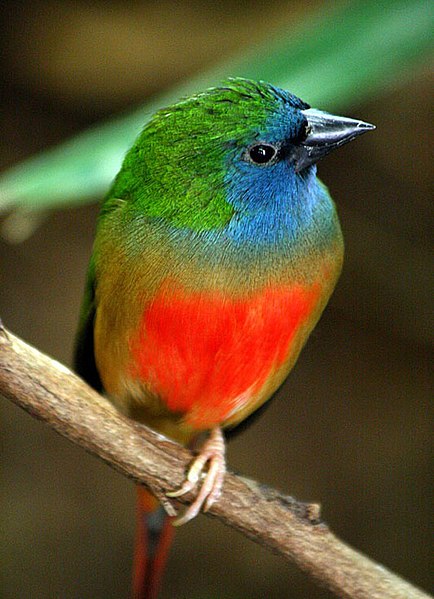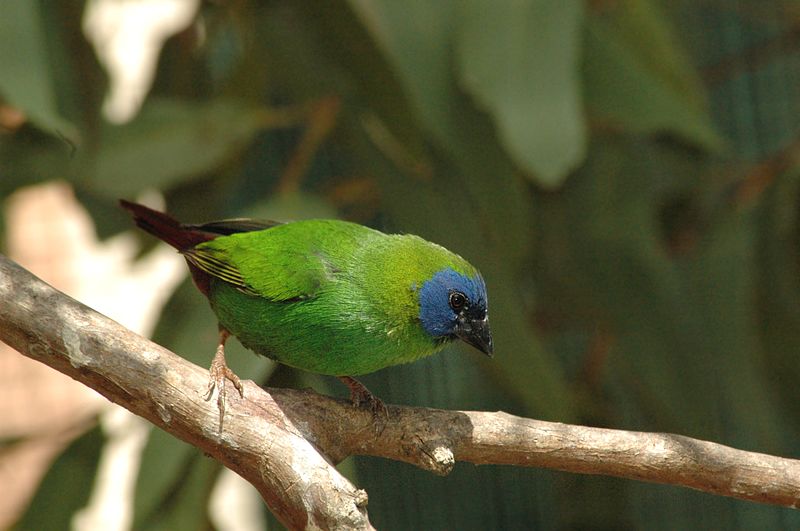 When translated to English, the French language name for this little finch – Nonpareil – means “without equal”. The name suits the gorgeous bird perfectly…so much so that aviculturists of all nationalities have adopted it. Also known as the Pin-Tailed Parrot Finch (Erythrura prasina), the brilliantly-colored Nonpareil has long been among the most desired of all Southeast Asian finches.
When translated to English, the French language name for this little finch – Nonpareil – means “without equal”. The name suits the gorgeous bird perfectly…so much so that aviculturists of all nationalities have adopted it. Also known as the Pin-Tailed Parrot Finch (Erythrura prasina), the brilliantly-colored Nonpareil has long been among the most desired of all Southeast Asian finches.
My first experience with these beauties came while working for a bird importer. I was captivated by their colors, but despaired over the stress caused them by shipment and confinement to quarantine facilities. Fortunately, an experienced private breeder helped me to learn the keys to keeping them alive and well.
Description
The 5.5 inch-long male Nonpareils are clad in “grass green”, bright red and brilliant blue, and sport elongated central tail feathers. Females have shorter tails and are not as gaudy, but are also quite colorful. While most related parrot finches are attractive (please see photos), none are as spectacular as the Nonpareil.
Yellow-bellied individuals are found in some wild populations, but are not common in captivity. Birds originating from Borneo have more blue in the plumage, and are considered by most to be a subspecies. Although few aviculturists see any need to experiment with color mutations, largely-green and pied strains have been established.
Range and Habitat
Nonpareils range from Myanmar through Thailand, Malaysia, Borneo, Sumatra and Java.
Habitat preferences are not well-studied, but they are most often observed along moist forest fringes and in bamboo thickets, brushy river edges and overgrown areas near rice farms.
Keeping Nonpareils
Nonpareils are notoriously shy and a bit high-strung, but when properly housed are quite hardy, and a delight to observe. They do well in colonies, and most successful breeders report they are best kept in this manner.
If confined to small cages or denied cover and visual barriers, Nonpareils will not thrive. When startled, they may fly into cage walls and become injured, especially if their enclosure is not correctly set-up.
Enclosure

The need for security and ample cover is one of the most important considerations in the husbandry of Nonpareils. While aviary-style indoor cages may work if one takes great care, outdoor aviaries or homemade indoor cages are the best options. Please see this site for an example of a well-planned indoor aviary.
Nonpareils, even those well-habituated to captivity, tend to hide when their enclosure is approached. Allowing them to remain out-of-sight when necessary will encourage a sense of security that will translate into healthier pets.
It is important to avoid startling Nonpareils – i.e. by suddenly illuminating a dark room – as they may explode into flight and injure themselves.
Light, Heat and Humidity
Full spectrum light, while not essential, may encourage breeding and other natural behaviors in Nonpareils that are housed indoors.
Native to warm, moist habitats, Nonpareils be kept at temperatures of 72-76 F and a humidity range of 50-60%. Temperatures to 90 F, and quite humid conditions, have been successfully used by some keepers.
Diet
Grass seeds form the bulk of the diet in the wild. Pets do well on a high quality finch seed mix, to which has been added extra canary grass seed and Japanese and white millet. Paddy rice (unprocessed rice with the kernel-covering intact) is a great favorite, and in the past was often used to induce newly-imported birds to feed.
A bit of egg food should be offered each day, with the quantity increasing when breeding behavior is exhibited. Small amounts of kale, watercress, sprouted seeds and other greens should be provided twice weekly. Live insects are usually ignored, even by breeding pairs.
Grit and both crushed and whole cuttlebone should always be available.
Most Nonpareils accept only a rather limited number of food items. To ensure against nutritional deficiencies, vitamin/mineral supplements should be provided (please write in for specific information).
Breeding
 Breeding results vary, as do the observations made by those who have been successful. Colony members seem to come into breeding condition more frequently than do single pairs; squabbles among males are rarely if ever serious. Breeding activity may vary greatly from year to year, despite similar captive conditions. Two molts occur each year; the failure of potential pairs to synchronize their molts is believed by some to interfere with successful reproduction.
Breeding results vary, as do the observations made by those who have been successful. Colony members seem to come into breeding condition more frequently than do single pairs; squabbles among males are rarely if ever serious. Breeding activity may vary greatly from year to year, despite similar captive conditions. Two molts occur each year; the failure of potential pairs to synchronize their molts is believed by some to interfere with successful reproduction.
The woven, enclosed grass or coco-fiber nest will be constructed in a basket, finch box, thick shrub or other protected space. The 2-6 eggs are incubated by both parents for 13 – 15 days. Soaked seeds, sprouts, additional egg food and chopped greens should be provided to the parents once the young hatch.
The chicks fledge in approximately 21-23 days, and are fed by their parents for an additional week or so. Adult plumage usually appears when they reach 8 months of age.
Parents that are disturbed may abandon their nests. Nonpareil chicks have been successfully fostered by Bengalese Finches.
Further Reading
Video: Building an Indoor Finch Aviary
NonPareil Finch image referenced from wikipedia and originally posted by Chaval BR
Fiji Parrot Finch image referenced from wikipedia and originally posted by Aviceda
Blue-faced Parrot Finch image referenced from wikipedia and originally posted by Nrg800
 That Bird Blog – Bird Care and History for Pet Birds
That Bird Blog – Bird Care and History for Pet Birds




Hello Frank,
I coincidentally stumbled upon this page, and I am impressed by the exquisite beauty of the species… Perhaps their beauty is on par with gouldians (both are erythrura, cousins?) if I could say so? But of course less pricy which means I may have a chance to adopt some.
So they’re shy? I guess taming would be a hard thing but I just have to be patient then…
May I ask about their durability? Are they as resilient as java finch? seeing how their origins were the same, Java… My plan is to keep them in aviary together with some canaries and java finch. Hopefully they’re not too vulnerable to catch and spread diseases.
Thank you
Hi Raymond,
Thanks for your note..they are spectacular, but they are often hard to find and expensive when available. I’ve not known anyone that worked at habituating them to hand feeding, etc; mainly a species to observe. They would not do well with javas or canaries…stressed, out-competed for food, picked on. Generally best in large, heavily planted aviaries with others of their kind. Some zoos have had success in mixing, but only in huge exhibits with other delicate species. Best, Frank
I see, thank goodness I asked!
So unless my aviary is heavily planted they will not have a chance at living? Guess I’ll have to postpone them… Can you suggest other species of hardy yet colorful bird species I could consider?
Thanks a ton
Hi Raymond,
Yes, they need lots of cover, height and so on,
Best, Frank
Frank.
I live in Thailand where the birds are fairly readily available and priced at about 4 pounds a bird.
My aviary consists of Zebras, Spice finch, Javas, Gouldians and 3 pairs of NonPareils that I introduced about 3 months ago and my aviary 5m x 4m x 3m high is fairly well planted up to roof height and the nons are skittish to say the least along with being very shy unlike the Zebs but no breeding from the nons yet but can live in hope but now you have said that Nons do well in larger numbers I will build a larger aviary for them alone and purchase more pairs so any advice on numbers for an aviary about 7m x 6m x 3m with adequate coverage would be appreciated.
Hi David,
I’m jealous!…they are hard to find here in the US and quite expensive! I’ve never tried a group in an aviary of that size…a dozen birds easily, probably more. Plant heavily but leave p;lenty of flight room as I’m sure you do in general…please keep me posted, sounds like an exciting project, best Frank